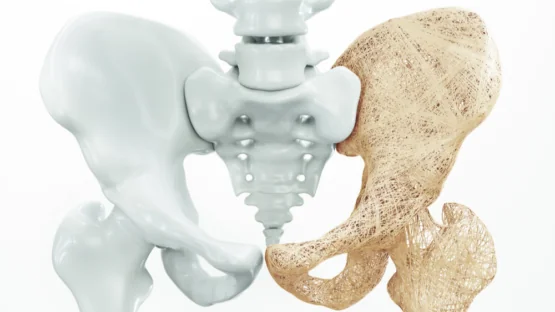A paper published in Experimental Gerontology has detailed how a bacterially derived compound may be useful in fighting osteoporosis.
Osteoblasts and osteoclasts
Osteoblasts are cells that build bone, and osteoclasts are cells that consume it. These two processes happen consistently and naturally in the human body. However, when osteoclasts consume bone faster than osteoblasts can rebuild it, this leads to the age-related degradation of bone known as osteoporosis [1].
There are two main current treatments for osteoporosis: biphosphonates and the human monoclonal antibody denosumab. While these drugs are the current standard of care, they have rare but serious side effects, including bone death (osteonecrosis) of the jaw and a loss of bodily calcium (hypocalcemia). Denosumab works by inhibiting RANKL, which is a signaling molecule of NF-κB and promotes the growth of osteoclasts (osteoclastogenesis). Therefore, these researchers decided to see if there might be a better method of approaching this target.
Previous research has shown that interferon regulatory factor 8 (IRF-8) inhibits osteoclastogenesis [3] and that suppressing IRF-8 enhances it [4]. This paper’s researchers also noted a recent paper showing that chemicals known as oligosaccharides inhibit osteoclastogenesis [5], although the effects of these chemicals on IRF-8 was not described. With this in mind, the researchers sought to determine if variants of the bacterially derived oligosaccharide glucuronomannan (Gs) and their derivatives (SGs) could be of help against osteoporosis.
A cellular study
The researchers first began their study by conducting tests on viability on RAW264.7 cells, a line of proliferating mouse cells that differentiate into osteoclasts when exposed to RANKL. SGs were found to be too cytotoxic; they killed too many cells and inhibited their proliferation. The larger, more polymerized, Gs were also shown to have this effect, so the researchers focused on only three remaining contenders: G2, G4, and G6.
All three of these prospective drugs were shown to inhibit genes relating to osteoclastogenesis when RAW264.7 cells were also exposed to RANKL, although not all of the genes were equally suppressed. Higher doses were more effective, and G6 was found to be the most effective of the three. As expected, all three drugs delayed the NF-κB signaling pathway.
Most importantly, these compounds were shown to have significant effects on the crucial parts of osteoclastogenesis. IRF-8, which was downregulated by RANKL, was restored, and the RANKL signaling pathway was impaired instead. Formation of the actin ring, a crucial part of osteoclasts, was suppressed. The researchers conclude that these results demonstrate potential effectiveness against osteoclastogenesis and osteoporosis.
Conclusion
This is a cellular study on a mouse line, one of the earliest phases of drug development. Even if this is shown to be effective in living animals, the trial process may discover that oligosaccharides have even worse side effects or are simply not as good as the standard of care. Better methods for fighting osteoporosis may be discovered before this approach proceeds through development.
Still, this research shows that there may be a way to dig deeper into the root causes of osteoporosis, discouraging the overgrowth of bone-eating cells and preventing the associated fractures, weakness, and loss of mobility.
Literature
[1] Rodan, G. A., & Martin, T. J. (2000). Therapeutic approaches to bone diseases. Science, 289(5484), 1508-1514.
[2] Gregson, C. L., Armstrong, D. J., Bowden, J., Cooper, C., Edwards, J., Gittoes, N. J., … & Compston, J. (2022). UK clinical guideline for the prevention and treatment of osteoporosis. Archives of osteoporosis, 17(1), 1-46.
[3] Zhao, B., Takami, M., Yamada, A., Wang, X., Koga, T., Hu, X., … & Kamijo, R. (2009). Interferon regulatory factor-8 regulates bone metabolism by suppressing osteoclastogenesis. Nature medicine, 15(9), 1066-1071.
[4] Kodama, J., & Kaito, T. (2020). Osteoclast multinucleation: review of current literature. International journal of molecular sciences, 21(16), 5685.
[5] Wang, S., Feng, W., Liu, J., Wang, X., Zhong, L., Lv, C., … & Mao, Y. (2022). Alginate oligosaccharide alleviates senile osteoporosis via the RANKL–RANK pathway in D-galactose-induced C57BL/6J mice. Chemical Biology & Drug Design, 99(1), 46-55.





